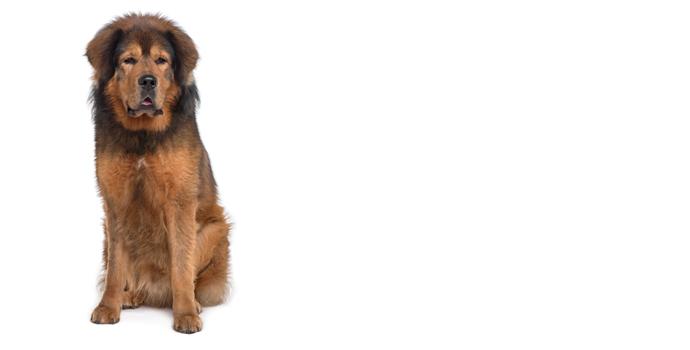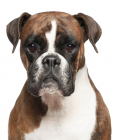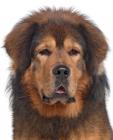Tibetan Mastiff

In my own words
“I’m a big, friendly giant! Don’t let my size put you off, come here and give me a cuddle!”
Back in Tibet, my kind used to work with Lhasa Apso’s to guard Tibetain palaces and temples. Can you imagine that? It was like little and large! We made a great team though. I can be pretty fierce you know, nothing scares me! I’ve got a big voice so I’ll tell you when trouble is about.
Don’t worry though, I’ll do anything for my family. I’ll do anything especially for cuddles! I mean, I’m like a giant teddy bear, don’t you think? There’s nothing I like more than a good cuddle on the sofa – if you can fit me on it! Well, there is one thing I like more than a cuddle... Ready for walkies? I am!
My ideal owner(s)
Active singles
Outdoorsy types
Families with older children
Experienced dog handlers
What they say about me
Quiet
Calm
Protective
Loyal
Please read on, to find out more about me, and whether I will be someone you can be happy with for the next 15 years, or even longer!
Is this Tibetan Mastiff for you?
Test your knowledge about the Tibetan Mastiff
Information essential about the Tibetan Mastiff
They are not necessarily suited to families with children, especially young children who may not be able to interpret its body language. If it does live with or have frequent contact with small or frail people, the sheer size must be considered as it is a very powerful animal.
Kennel Club Group:
Working
The Tibetan Mastiff is a member of the working group. They were originally used for guarding villages and monasteries and their livestock. Today they are guard dogs, companions and seen in the show ring.
Size:
Extra Large: Weight 140 – 180 lb (64 – 82 kg)
Height Male 28 – 29” (71 – 73.5 cm) Female 25 – 28” (63.5 – 71 cm)
Popularity:
Breed History:
The Tibetan Mastiff is an ancient breed which has been largely unchanged over the centuries due to the remoteness of its native lands on the Tibetan Plateaus. Locally they are known as “Do-Khyi” which means “tied dog”, reflecting the fact that they are often tethered to the entrance of their owners tents or houses. It is thought that many other breeds descend from the Tibetan Mastiff such as the Newfoundland and Pyrenean Mountain Dog. For thousands of years this dog has worked in conjunction with the Lhasa Apso, guarding Tibetan temples and palaces.
They began to appear in other countries when Alexander the Great took them with him on his travels around the world. At first, these Tibetan dogs were seen as curiosities in England and were placed in zoos. In 1847 the Viceroy of India, Lord Hardinge, sent one of these dogs named Bhout to Queen Victoria, although there is no record of any subsequent breeding from it. The Tibetan Mastiff we know today has been known to exist outside Tibet for over a century. In the 1880’s the Prince of Wales owned at least one of these dogs, and the breed standard was created in the 1930’s.
Character:
This breed is fiercely loyal and protective of its family and home. It makes an outstanding guard and watch dog and is best suited to an owner with experience of this type of dog. While it is thoughtful, quiet and calm, this breed requires strong, firm and consistent leadership otherwise it will establish itself in the dominant place in the household. They can be very affectionate and gentle when treated with respect. The Tibetan Mastiff has a dignified manner and is calm and gentle with family members. They make a great cuddly pal and beloved friend. They are respectful and caring with children but can be slightly reserved and aloof around other dogs and strangers. This breed requires proper socialisation and training to mould its protective instinct. Overall, the Tibetan Mastiff has a strong sense of independence combined with a need for family time and affection.
Temperament:
This breed naturally wants to guard and protect its family and territory. They require early socialisation because sometimes this breed can be aggressive and stubborn. Most are very gentle, patient and loving with people and children they know but are generally distrusting of strangers. This breed is calm, thoughtful and dignified but can also be stubborn, dominant and self confident. This breed can be a nocturnal barker with a loud booming voice.
Conformation:
This breed is a massive dog with sturdy and quite heavy bone structure. The body is slightly longer than its height. The massive head is wrinkled, broad, heavy and strong with a square shape to it and the muzzle. The large nose is black and the upper lip usually covers the lower lip. The slightly slanting and drooped eyes are almond shaped, brown, deep-set and not to large considering the size of the head. Ears are a pendent V shape which hang forwards. The head is supported by a very muscular neck, which gives ways to a level, strong back. The feathered tail is held curled over the back.
Coat:
The double coat is very heavy, durable and thick with a heavy mane around the neck and shorter hair on the head. The legs and belly are feathered profusely.
Colour:
The coat desired are black, black and tan, brown, shades of gold or grey and grey with gold markings. Limited white is allowed on the chest and toes. They can have tan markings on the muzzle, above the eyes, lower part of the legs and on the tip of the tail.
Training:
This breed requires proper socialisation and training from a young age. They require consistent and firm training as they can be stubborn and dominant so ensure this dog knows its place within the family. They do not respond well to harsh or heavy handed training.
Care:
Due to its long coat, this breed needs brushing at least every other day and requires regular checking for any sign of skin complaints. This breed sheds once a year and at this time the heavy coat will come away in large chunks. During this period they require careful grooming to remove any dead hairs. When they are not moulting this breed is very easy to maintain. Once a year anytime between April – July, they have a summer moult, which can last up to 6-8weeks, They blow all their undercoat out, which comes out in clumps of wool. Their winter coat starts to grow in by August – September. Compared to short haired breeds (Mastiff, Bullmastiff etc) they do not constantly shed hairs all the time. As puppies the Tibetan Mastiff should have a nutritious diet to ensure the proper formation of the bones and joints. Supplements should not be added to the diet unless absolutely necessary as they can do more harm than good. There are reports of the adolescent dog being a picky eater. Care should be taken that the protein levels do not exceed 20-22
Health:
The lifespan of a healthy individual is up to 15 years. If you buy from a reputable, responsible breeder, health problems should not occur. This breed is prone to hip dysplasia and can develop skin allergies as they age. It is important not to over exercise this breed when they are young to prevent strain on their growing bones. This breed can also suffer heart problems and thyroid deficiencies.
Exercise:
This breed is not overly active but does require a certain amount of exercise. Daily walks of about 40 - 60 minutes per day are essential to keep this dog healthy and keep its weight under control. The young dog should have all exercise monitored while it is still growing to ensure that no damage occurs to the bones and joints. They do enjoy exercise and enjoy a ramble in the countryside and through the woods. Provided they are walked and socialised, they are very content to lay around snoozing all day, but one eye is always open on guard. They are not too keen on playing games with balls and other toys.
You may also like:
If you like Tibetan Mastiffs, you may be interested in breeds of the same size »





If you like Tibetan Mastiffs, you may like other breeds with similar characteristics »





If you like Tibetan Mastiffs, you may be interested in these other working dogs »





Advice on choosing your breed »
Find an animal shelter or rescue home where a Tibetan Mastiff is waiting for a new home »
The following grid gives a fast track review which covers all breeds. You can apply it to help you decide if a Tibetan Mastiff is suitable for you, the environment where you live, your personality and your lifestyle. On the grid, 1= strongly disagree, and 5= strongly agree. For example, if you are looking for guard dog, look down the list under Role and Suitability, and you will see that Tibetan Mastiffs make excellent guard and watch dogs, scoring 5. You might like to save or print off this section and keep it for reference while you check some other breeds before making your final choice.
Be the first to rate this breed »
|
*PLEASE NOTE: All our breed profiles are general, and all dogs are individuals. Always talk to the breeders and meet the owners you are buying from. Try to meet the dog and its parents if it is a puppy in their home environment.














